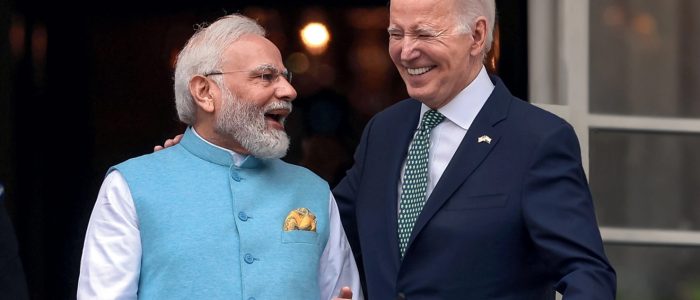Indian Prime Minister (PM) Narendra Modi’s visit to the United States (US) from 20 to 25 June at the invitation of US President Joe Biden was a manifestation of strategic re-alignment. This was PM Modi’s first state visit to the US since Biden took office in January 2021 and the first official state visit by an Indian leader since 2016.
Modi’s visit to the US portrayed the Indian interest in keeping a partnership between the two states and a foot in the US Indo-Pacific strategy amid rising competition with China. As written by an Indian columnist, “This is a significant visit that will showcase the strength and depth of the US-India relationship. It will also communicate to China that the US and India are united in their vision for a free and open Indo-Pacific.” This visit was not just pomp and symbolism; the US wants to bring India deeper into its manufacturing and defence, with the added benefit of helping wean New Delhi’s military off Russia and US supply chains off China.
Another aspect of India’s relations with the US is its long history of a strategic partnership with Russia, which likely appears to have become an indispensable partner. Instead, the Indian strategic partnership with the US is relatively new. India never compromised the longevity of its relations with Russia over the US. Therefore, it may not be wrong to say that the US has invested more in this strategic alliance than is needed.
The US wants to bring India deeper into its manufacturing and defence, with the added benefit of helping wean New Delhi’s military off Russia and US supply chains off China.
During this planned visit to the US, both sides laid the foundations of several expected agreements on semi-conductor chips and fighter jet engines that have been in the works for months, bolstered by visits to New Delhi by Secretary of Defense Lloyd Austin and National Security Advisor Jake Sullivan. During the visit, the two sides reportedly sealed a deal for India to buy more than two dozen American drones. Another segment was the approval of the Indian Defence Ministry for a $3bn drone deal with the US on Modi’s visit. The deal includes the purchase of 30 MQ-9 Reaper or Predator B drones.
The Reaper comes with nine hard-points, capable of carrying sensors and laser-guided bombs besides air-to-ground missiles. It has an endurance of over 27 hours and can operate up to 50,000 ft. with a 3,850 lb. (1,746 kg) payload capacity that includes 3,000 lb. (1,361 kg) of external stores. It is capable of carrying multiple mission payloads, including electro-optical/infrared (EO/IR), lynx, multi-mode radar, multi-mode maritime surveillance radar, electronic support measures (ESM), laser designators, and various weapons and payload packages. The Indian Navy has already leased two unarmed versions of the drone Sea Guardian. India requested that the American manufacturing firm General Atomics establish a regional maintenance, repair, and overhaul facility for drones in India. The Navy had initially planned for 22 Sea Guardians, priced at over $2bn, but then brought down the number to just 12. Since all three Indian services wanted weaponised drones, a decision was taken to pursue the deal jointly.
These strategic decisions by India are aimed at securing a strongman status. The primary factor behind the Indian race achieving strongman status is the Chinese growing naval and economic power. By creating a bogy around the presumed Chinese “string of pearls,” India is adopting a “necklace of diamonds” approach.” As experts argue, India may modify its 2015 doctrine soon and include an anti-China encircling policy.
India expanding its technological edge could create a security dilemma for South Asian states, particularly Pakistan, against which the stark majority of the former’s military arsenal is directed. The Indian appetite will also prod China to secure its regional interests because China is being seen as another major source of mutual concern pushing Washington and New Delhi closer together. Whereas, India’s relationship with China deteriorated far earlier and much more spectacularly, with military confrontations on their shared border, and such deals will facilitate the Indian purge to substitute reliance on Chinese technology. Moreover, Chinese naval expansion into the Indian Ocean has also compelled India and reinforced the importance of the so-called Quad group of countries. Meanwhile, the US and its allies are attempting to restructure and “friend shore” global IT supply chains to lessen reliance on China, which has spent years establishing itself as the world’s manufacturing floor.
The massive build-up of the Indian new generation of drones and naval nuclear force speeds up the arms race, compelling border-sharing states China and Pakistan to follow suit. It also impacts the nuclear thresholds and enhances the risks of unintended nuclear escalation due to misperception from land to sea domain while simultaneously increasing their vulnerability, thus becoming a major concern for maintaining regional stability.
India’s arms induction into the defence and strategic inventory presents a scenario to reassess the regional and global security environment. Several things can be taken into account to map regional and global stability options. There is a need to preserve existing arms control mechanisms, devote sincere efforts to reducing nuclear risks, and negotiate new arms control arrangements. This has to be pursued at the global and regional levels. Especially a Strategic Restraint Regime in South Asia is vital to reduce and avoid nuclear risks. There is a need to develop a comprehensive legal, regulatory regime for emerging and disruptive technologies that could increase nuclear risk.
In Asia-Pacific, there is a need to avoid arms races and crisis instability. Stakeholders should find ways to extend both formal and informal rule-making. There is a need to pursue conflict resolution and build strategic stability. Decision-makers must prioritise resolving disputes and meaningfully engaging in arms control and cooperative initiatives to achieve this goal.
